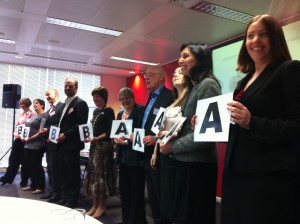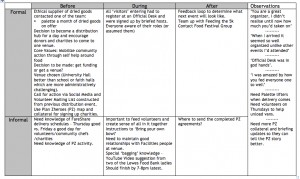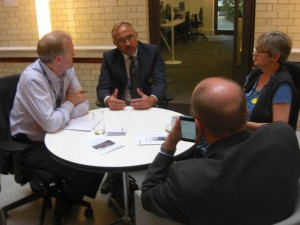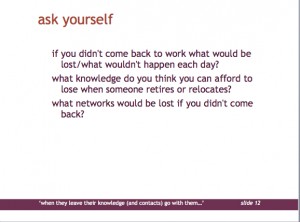I was in virtual conversation today with Professor Fernando Sousa, President of APGICO, the Portuguese Association for Creativity & Innovation whose aims are to:
- develop, disseminate and promote knowledge and experience in the management of organizational creativity and innovation;
- establish international contacts with similar organizations;
- create forums for dialogue between businesses, academic institutions, government agencies and other stakeholders in the management of creativity and innovation.
APGICO has all the right characteristics to become a Knowledge driven organisation where collaboration and co-creation are at the heart of everything they do!
Fernando and I first met 5 years ago when we were part of an Advisory Board assembled to look at future business options for a traditional hand weaving business based in the Alentejo region of Portugal. Fernando subsequently invited me to be a guest speaker at an EU Creativity & Innovation event Portugal hosted during which he used stories to develop themes and we’ve shared ideas ever since and recently met for tea in Faro.
I mention this since despite a number of conversations Fernando, like many, struggles to ‘get’ Knowledge Management though he appreciates the ideas behind it, the techniques that underpin it and the value of stories to unearth new meaning. In his own words:
Although I have some difficulty in entering your field of expertise, I always find your texts and slides quite interesting; in fact, I find some of them are true mind breakthroughs
While generous (thank you Fernando) it means I haven’t expressed the message clearly enough in language that he understands or in context which goes to the heart of a conversation I’ve been following this week on KM4Dev started by the World Bank entitled ‘PDFs that nobody reads’.
KM – the dangers of a supply led model
Here’s an extract from one of the many excellent contributions to the KM4Dev discussion, this by Lata Narayanaswamy, Honourary Research Fellow at University of Sheffield:
It is this question of what people actually do with all the reports and newsletters and information packs that we as development professionals produce, and I absolutely include myself here. My own research in this area would suggest that, in contrast to so many members in this forum in particular, who work to promote KM as an interactive, engaged, two-way, back and forth communications process, a large proportion of what passes for KM is the production of a PDF that gets posted on a website. It is a supply-led model that reflects what both Philipp and Magdaline have identified as the lack of reflection on what people actually want to know, and instead focuses on what organisations either want to share or what they think people should want or need to know and ‘how’ to know those issues. ……
Given the diffuse nature of what we call ‘development’, it is not therefore surprising to find that the World Bank, despite their powerful financial and discursive position, is experiencing a ‘no one is really reading our stuff’ problem, because broadcast mode has always been an essential part of their KM framework and the way in which so much of civil society has understood what is means to ‘do’ knowledge.
And whilst I believe that engaging with and articulating the demand for knowledge is hugely important, I am under no illusion that engaging with demand alone is going to address this issue. I myself as a practitioner have been in plenty of situations where someone has requested information (presumably this counts as engaging with demand!) and I subsequently learn that they didn’t use it. I think Peter’s example of ‘information that might be useful if only we had a budget to engage people with it’ really highlights that KM is not only about demand or supply but a continuous process of recognising the value of information to the knowledge creation process.
My own observations on that discussion were:
I’ve been working a fair bit recently with and in Middle East and Africa and very aware of the challenges of publishing dry English reports to audiences where English is a subsidiary tongue. I’ve tried using the power of 3 (3 bullets, 3 themes), stories and postcards to bring ’stuff’ to life. But ultimately it takes a seismic shift for people to change ingrained habits.
One of my early corporate assignments was to set in place a business intelligence function which collated and summarised salient content for senior officers. Later, technology sought to replicate this but was never quite able to replicate the knowledge of an individual who knew the business inside out. In a way this was how the Knowledge Manager in that business emerged – a person who knew and understood the business providing the right content (with opinion) to those who were best able to use it.
I’ve been working with one of the leading Gamification experts and will be facilitating a debate on the subject at KMUK and with David Gurteen at a Knowledge Cafe in a few weeks time. Its a similar issue – how to get engagement with an audience, a problem increasingly exacerbated by the behaviours of Generations X, Y & ‘Rent’ whose learning and reading styles are driven more by social than traditional push technologies.
identifying the value of Knowledge Management
So I was delighted when Nick Milton published the extract from a presentation to financial analysts made by ConocoPhillips last month in which one of their Vice Presidents described the value of Knowledge Management to that organisation – take a look at Nick’s blog. The comment that really hit me was:
The knowledge sharing group that we have that drives all of this is embedded in our IT organization, which is embedded in our technology and projects organization.
So it’s well integrated with all our other functional groups and we look at maps of how knowledge is being shared from one part of the world to the other and across different functions and can actually track how well that is working and it’s been pretty impressive what it has done for us.“It is actually one of the key tools that we are using today to combat the great crew changes, we call it in our industry, where we have so many people with so much knowledge who are retiring and we’ve hired all of these younger people. A big part of how we do that knowledge transfer from the experienced folks to the less experienced folks is using these tools.
Value creation is at the heart of the Knowledge Asset Management Methodology, Ron Young has helped many organisations adopt. It is based on a concept of frequent value assessments with measurements (Change Readiness / Stakeholder Analysis / KM Maturity Models as examples) and the idea of embedding a 9 step Knowledge Management process into the day to day workings of an organisation. It further calls for the identification of an organisation’s Knowledge Assets, a serious attempt to measure the intrinsic value of processes, communities and individual, team and organisational knowledge and networks.
For many years Ron, along with others in the KM arena, has been calling for a mechanism that places a value on these Knowledge Assets and while the ConocoPhillips briefing is some way off that it is a move towards that goal. Lest we should forget, a few years back a correlation was made between the winners of MAKE awards and their outperformance on the US stock market.
I believe Risk Management is also of huge significance and why the Nuclear Industry pay attention to the capture of Critical Knowledge identifying who has it and what they could least afford to lose through natural wastage or downsizing. As yet, factoring in the value of a loss of Critical Knowledge as a potential risk does not feature in the Audit and Compliance reports of most organisations and I for one believe it should.
and finally
So what do I take from this?
- Knowledge Management needs a foundation of good Information Management;
- To be effective (and sustainable) Knowledge Management must be embedded in the processes of an organisation and focus on business issues;
- While stories bring experiences to life, you can’t assess what you don’t measure and if you don’t map and measure (frequently) you are reliant on anecdotal evidence which at the top level of organisations won’t wash for long; and
- Its easy to produce ‘product’ that looks good but not relevant or in context for the audience – pushing at an ajar door on the lower levels is a lot different than banging on a locked door at the top of the building!







